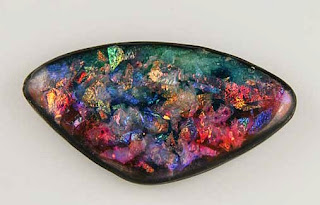 Sometimes it's fun to try a tutorial or two to see how someone else does a particular effect. Faux rock and stone looks interest me, as do mosaics. When I recently stumbled on some tutorials by Leggende Segrete, I had to give her Glass Mosaic Beads a try. These pieces look to me like shiny pebbles with a sort of honey-combed effect, hence the name.
Sometimes it's fun to try a tutorial or two to see how someone else does a particular effect. Faux rock and stone looks interest me, as do mosaics. When I recently stumbled on some tutorials by Leggende Segrete, I had to give her Glass Mosaic Beads a try. These pieces look to me like shiny pebbles with a sort of honey-combed effect, hence the name.
For the first set I made, I used homogeneous colors in the gold/orange/yellow family. As you can see in the photo, the color turned out to be so subtle it was almost not visible. The gold composite leaf underneath does shine through clearly in these.
 I decided to work with gold again, and use more definitive colors. The next batch pictured on the sand dollar have fuschia and green coloration. More color, but still somewhat subtle.
I decided to work with gold again, and use more definitive colors. The next batch pictured on the sand dollar have fuschia and green coloration. More color, but still somewhat subtle.
Next, I tried using silver composite leaf for the background, and went with blues and purples. This combo looks more like painted rocks, and they're very pretty.
Last, I had to see how little honey combed pebble earrings would look. They're rather sweet, and not something you see every day.
















































